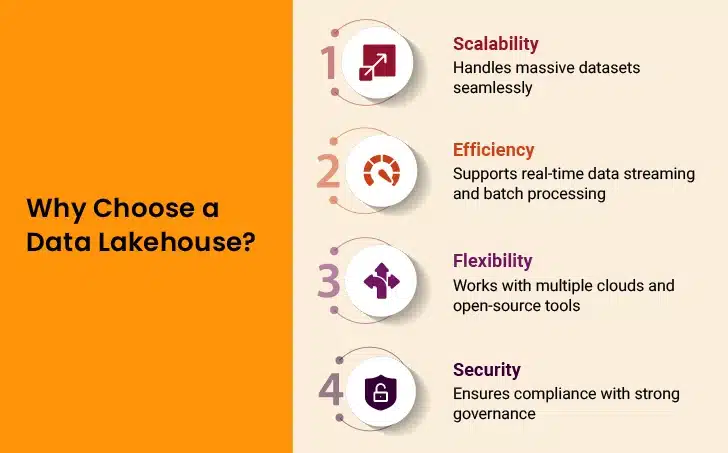Managing the diverse processes of data engineering—from ingestion to transformation and analytics—can become overwhelming due to inefficient pipelines, fragmented tools, and complex workflows.
A data lakehouse is an innovative and more advanced data architecture that enhances data engineering, combining the best aspects of data warehouses and data lakes. It is a modern, multi-layered data management approach that integrates the scalability and flexibility of data lakes with the performance, governance, and reliability of data warehouses.
Earlier, organizations attempted to bridge the gap between data lakes and data warehouses by implementing a two-tiered architecture. This required extracting, transforming, and loading (ETL) data from a data lake into a warehouse for structured analytics and business intelligence. However, this approach introduced latency, redundancy, and increased costs.
The data lakehouse eliminates the need for a two-tiered system by integrating the flexibility and scalability of a data lake with the performance, reliability, and governance of a data warehouse into a single architecture. Several technology vendors, such as Snowflake, Databricks, Amazon Redshift, etc., offer the expansive benefits of data lakehouses with slightly different architectures. However, data engineering with Databricks tops the charts.

In this guide, we will explore best practices for a successful Databricks migration. We’ll cover ways to streamline data workflows, improve efficiency, and scale operations with Databricks. Let’s get started!
Table of Contents
The Importance of Choosing the Right Data Lakehouse Platform
5 Pillars for Evaluating Lakehouse Platforms
- A Unified Data and Analytics Architecture
- Unified Governance in a Data Lakehouse
- Enhances Data Analytics
- Improves Compatibility with Open-Source Standards
- Built for Modern Data Needs and Use Cases
Best Practices for a Smooth Transformation Journey to Databricks Lakehouse
The Importance of Choosing the Right Data Lakehouse Platform
Selecting the right data lakehouse platform is crucial for companies that rely on data-driven decision-making. An optimally designed lakehouse means data processing is efficient, accessible, and secure. The absence of the right platform may result in sluggish performance, data silos, and a negative return on investment.
Databricks for data engineers provides a robust solution by facilitating integrated data and real-time analytics. With advanced data engineering with Databricks, companies can create scalable pipelines that manage big data sets effectively. An effective lakehouse platform also provides AI-driven insights, enabling organizations to make better predictions and improve operations. The right solution guarantees long-term success in data management and analysis.
5 Pillars for Evaluating Lakehouse Platforms
1. A Unified Data and Analytics Architecture
A lakehouse is a modern approach to data storage and analytics. Before adopting it, businesses should understand how it differs from data warehouses and lakes to see if it fits their needs.
First, data storage is more flexible in a lakehouse. Unlike warehouses, which store only structured data, a lakehouse holds both structured and unstructured data—including text, images, videos, and streams—in their original form.
Next, analytics capabilities go beyond basic reporting. Traditional warehouses mainly support dashboards and reports, while lakehouses enable advanced analytics, including machine learning and AI-driven insights.
Querying and structuring are more efficient in data lakehouses. Data lakes store raw and semi-structured data but don’t support direct queries. In contrast, lakehouses allow fast searching and analysis, combining the strengths of warehouses and lakes.
Older data lakes did not separate computing power from storage, meaning both had to grow together, thus increasing costs. Data lakehouses separate them, allowing each to expand independently. They are usually cloud-based, offering flexible scaling and affordable storage.
Finally, many data lakehouses use tools that help organize data, automate workflows, and detect quality issues. The system often builds a data warehouse on top of an open data lake file format like Parquet.
Lakehouse Architecture Overview
A data lakehouse typically has several layers:
| Storage Layer | Holds structured, semi-structured, and unstructured data in an open file format. |
| Metadata Layer | Manages data details, including file descriptions. |
| Processing Layer | Handles data transformation and processing. |
| Semantic Layer | Includes data catalogs and indexing. |
| API Layer | Supports fast SQL queries and data frames (used in data science tools). |
| Consumption Layer | Provides access to analytic tools for reporting and decision-making. |
The modern data lakehouse structures data, allows updates and edits, and supports efficient querying and analytics. Its flexibility and advanced features make it a sound choice to manage large and diverse data sets.
2. Unified Governance in a Data Lakehouse
One of the most important aspects of a data lakehouse is having a unified governance layer. Data governance includes rules and procedures companies use to abide by data policy and ensure data quality. Data governance is a primary focus for businesses. However, it poses an immense challenge with cloud systems. Over the past several years, vendors have expanded efforts to solutions for improved control over data. A robust data lakehouse must incorporate the following tools and services within a single governance system:
- Data Quality Tools: Data quality tools ensure that data is accurate and trustworthy for reporting, searching, analytics, and other purposes. Contemporary data quality tools automate sorting, standardizing, correcting, and combining data. They also enable users to define and revise rules to ensure data quality.
- Data Catalogs: Data catalogs assist users in locating and comprehending data from various sources. They also define the data and offer additional functions, such as automatic data cleaning, detecting sensitive data, and monitoring data structure changes. Some catalogs even record actions performed on data to satisfy audit purposes.
- Data Lineage Solutions: They track the data’s origin, alterations, and dissemination. Several data catalogs also offer lineage tracking. This helps organizations maintain data integrity, troubleshoot issues efficiently, and ensure regulatory compliance.
- Compliance Tools: These tools enable organizations to comply with data handling and storage regulations. They control data reuse, cross-border data transfers, and data deletion in cloud infrastructure. Regulations such as the GDPR (General Data Protection Regulation) in the EU and the CCPA (California Consumer Protection Act) in the US have stringent requirements for safeguarding customer data. The regulations also make it more challenging to control data sharing and question where customer data is stored.
- Data Protection and Security: A data lakehouse should have robust security controls, such as restricting access to sensitive information, enforcing schema rules, and safeguarding data in motion, in use, and at rest. Encryption or masking mechanisms help protect valuable information.
Data Engineering with Databricks
Databricks offers a powerful platform for data engineering and simplifies large-scale data processing, management, and governance. Databricks data engineers use these tools to automate data pipelines, enhance data quality, and achieve data compliance with regulations. Through Databricks, organizations simplify data governance and security while maximizing their data workflows in a lakehouse architecture.
3. Enhances Data Analytics
A prime characteristic of a data lakehouse is that it supports all analytics, from simple queries and visual data discovery to complex AI and machine learning.
Self-service BI automatically highlights the most important insights, making it a top priority for modern businesses.
To facilitate a broad set of analytics, a data lakehouse ought to provide:
- Simplified Access to all Data: A data lakehouse breaks silos between a data warehouse and a data lake. This helps users analyze big datasets or various data forms without jumping between systems.
- Support for Varying Data Types: Machine learning and other analytics require extensive sets of different data. For instance, an organization may need to aggregate structured billing data with unstructured customer feedback. A data lakehouse facilitates it.
- Third-Party Data Integration: External data, including demographics, weather, or industry trends, complements analytics. Some data lakehouses have data marketplaces for purchasing and selling data.
- Tools for Various Users: A data lakehouse must be able to handle both open-source and commercial tools. Databricks data engineers, analysts, and developers require access to the tools that suit their positions. Certain organizations might require support for data frames in R or Python, whereas others need APIs that integrate with platforms such as TensorFlow or other AI tools.
- Producing Production Models: A data lakehouse should process data quickly to enable machine learning and AI. This helps businesses use predictive models in real-time situations.
Organizations dedicated to data engineering using Databricks reap the rewards of a properly designed data lakehouse. A Databricks data engineer streamlines workflows, enables seamless integration, and expands analytics capability within one platform.
Accelerate Your Data Pipelines with Databricks
4. Improves Compatibility with Open-Source Standards
When a company relies too much on one vendor’s products, switching to another provider is hard and costly. This is called vendor lock-in. Proprietary software often causes this because the vendor tightly controls it. In contrast, the community creates and updates open-source standards. They help different systems work together, encourage new ideas, and let companies switch tools more easily.
Many businesses worry about vendor lock-in with cloud-based data platforms. They want their data to be in an open format compatible with multiple processing tools and data engineering code to work on other platforms if needed.
While open standards are not required for a data lakehouse, many modern lakehouses use them. If the company values flexibility, consider platforms that support open standards. This involves storing data in open formats, allowing businesses to use different processing engines.
Three popular open-source data table formats used in data lakehouses are Delta Lake, Apache Hudi, and Apache Iceberg. They help manage large datasets by providing features like:
- ACID transactions (keeping data reliable and secure)
- Data versioning (tracking changes over time)
- Data quality and governance (ensuring data accuracy and organization)
- Time-travel queries (retrieving past versions of data)
These open-source tools work with many big data frameworks and fit into existing data pipelines. Data engineering with Databricks is a great example of using open-source technology effectively. A Databricks data engineer works with these formats to build scalable, high-performance data systems.
5. Built for Modern Data Needs and Use Cases
The data lakehouse brings all data types into one platform for better storage and analysis. To keep up with today’s data needs, it must support:
- Multicloud Environments: Many companies use more than one cloud provider (usually two or more). A cloud data lakehouse must bring data from multiple clouds into one unified system. It should also support data governance across these clouds and provide a single view of all data, including metadata.
- Batch and Streaming Data: More businesses now use real-time data streaming for quick insights. A modern lakehouse must support batch processing (large amounts of stored data) and streaming data (real-time updates).
- Scalable SQL: A data lakehouse needs strong SQL capabilities that work with open table formats while supporting large-scale queries, complex joins, and multiple users working simultaneously.
- Data Sharing and Collaboration: Companies are shifting to data-sharing strategies to get more value from their data. This is especially useful in supply chains, where businesses share inventory forecasts with customers and partners to improve efficiency. A modern data lakehouse should allow teams to share data securely for internal use or monetization (like customer dashboards and applications).
A strong lakehouse platform also helps data engineers, data scientists, and ML engineers work together by making data easier to share across different tools and security models. Advanced data engineering with Databricks supports these capabilities by allowing teams to process, manage, and analyze large-scale data.
Another key feature is the data catalog, which helps manage, search, and share data across an organization. The lakehouse must make it easy for users to find and access shared data for better decision-making.

Best Practices for a Smooth Transformation Journey to Databricks Lakehouse
I. Find the Right Balance Between ‘Lift and Shift’ and Full Refactoring
When moving to Databricks Lakehouse, companies often struggle to decide between a simple migration (lift and shift) or complete restructuring (refactoring). A direct lift and shift is quick and easy but may carry over old system issues. On the other hand, complete refactoring improves performance and efficiency but takes longer and requires additional training.
A balanced approach is the best solution. This starts with analyzing existing workloads to identify unnecessary complexities, dependencies, and opportunities for improvement. A step-by-step strategy helps prioritize components for retention versus optimization for the Databricks environment.
II. Study Workload Patterns to Set Priorities
One of the biggest challenges in modernization is deciding which applications and workloads to migrate first. In-depth workload analysis helps identify high-value business cases that deserve prioritization.
Understanding how different datasets and processes depend on each other makes it easier to avoid disruptions. A data lineage analysis traces data from its source to its ultimate use, while process lineage helps map relationships between scripts, jobs, and workflows.
Using advanced data engineering with Databricks, organizations gain complete visibility of scalable data pipelines, reduce risks and plan a structured migration process instead of rushing everything.
III. Fix Issues in Legacy Systems Before Migration
To get the best cost-performance balance on Databricks, it’s important to identify and fix inefficiencies before migration. This includes:
Optimizing database structures to follow best practices, including:
- Converting legacy features like Teradata single-AMP joins or Azure Synapse indexing into Databricks-compatible formats
- Removing inefficient code patterns that slow down query performance, especially for large datasets
- Updating job scheduling to run tasks in parallel instead of sequentially for better efficiency
Databricks’ Adaptive Query Execution (AQE) further enhances query performance by adjusting execution plans dynamically based on real-time data.
IV. Design a Future-Ready Architecture
A flexible and well-structured data architecture is key to supporting advanced analytics and business intelligence. An ideal Databricks Lakehouse setup should include:
- Migrating all on-premises systems (data warehouses, ETL, analytics tools, etc.) into a Databricks-native environment
- Building automated data pipelines to move and transform data
- Ensuring secure data transfers using cloud networking services like AWS Direct Connect or Express Route
- Running optimized workloads on Databricks Workflows and ingesting data into Delta Lake
- Setting up cloud security protocols for access control and compliance
With advanced data engineering with Databricks, businesses build a high-performance Lakehouse that integrates seamlessly with BI tools and enables self-service analytics.
V. Migrate Workloads End-to-End, Including Business Logic
Data migration is just one step in the journey. Companies must also move and optimize their business logic to fully benefit from modernization. This includes:
- Transforming legacy database scripts into Delta Lake tables
- Converting SQL and procedural logic into Databricks SQL and PySpark
- Updating job schedulers (like AutoSys or Control-M) to Databricks-native workflows
- Rewriting ETL scripts into PySpark notebooks for better scalability
- Optimizing schema and code with Databricks performance tuning techniques
This process ensures that all data processing, analytics, and reporting functions work efficiently in the new environment.
VI. Plan a Phased Migration and Decommission Legacy Systems
A step-by-step migration strategy is better than a one-time switch (big bang approach). Phased migration helps:
- Reduce risks and avoid downtime
- Control cloud costs by shutting down old systems gradually
- Ensure a smooth transition with testing and validation at each stage
Once the Databricks system is fully operational, it’s vital to decommission the legacy infrastructure to prevent unnecessary expenses and maintenance efforts.
VII. Operationalize and Optimize Workloads on Databricks
After migration, the last step is stabilizing the new system and optimizing it for long-term success. This includes:
- Running workloads in parallel to compare performance before full deployment
- Setting up DevOps and CI/CD pipelines for smooth operations
- Integrating third-party data engineering tools and services for automation
- Configuring cost-saving features like auto-scaling and resource optimization
- Implementing security measures like SSL, Active Directory integration, and compliance monitoring
Databricks-native services help businesses maximize efficiency, ensure security, and streamline operations in their modern data environment.
Conclusion
Modernizing ETL processes is essential for businesses that want to handle large and complex data. Lakehouse architecture combines the best features of data warehouses and lakes, making data storage, processing, and analysis faster and more flexible. Databricks for data engineers provides a powerful platform to build scalable pipelines, automate workflows, and improve data governance.
By following best practices, organizations migrate smoothly to Databricks Lakehouse, optimize workloads, and enhance analytics. A well-planned approach ensures better performance, cost efficiency, and long-term success. With the right Databricks data engineers, businesses unlock the full potential of their data and drive smarter decisions.





